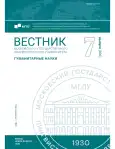Street Names of Polylingual Regions: Legislative Guidelines and Naming Practice (on the example of Belarusian and Italian borderland)
- Autores: Panteleenko A.A.1
-
Afiliações:
- Minsk State Linguistic University
- Edição: Nº 7(901) (2025)
- Páginas: 99-106
- Seção: Linguistics
- URL: https://ogarev-online.ru/2542-2197/article/view/303327
- ID: 303327
Citar
Texto integral
Resumo
The article is devoted to the identification of similarities and differences in the formation of the names of linear objects, motivated by proper names, on the example of Italian and Belarusian borderland, characterised by the situation of closely related bilingualism. The material of the study is the names of streets, squares, alleys and other linear objects of the Belarusian city of Vitebsk and the Italian city of Aosta. The methods of quantitative data processing and photo-fixation, as well as introspective, descriptive and comparative methods were used. The research establishes both similarities and differences in the naming practices of the two cities related to the situation of closely related bilingualism and historical development of the regions.
Sobre autores
Alessia Panteleenko
Minsk State Linguistic University
Autor responsável pela correspondência
Email: alessia@list.ru
PhD (Philology), Associate Professor, Doctoral Candidate of Speech and Communication Theory Department
BelarusBibliografia
- Panteleenko, A. A. (2023a). Linguistic landscape of a multilingual city: regional specificity (by the material of the Italian city of Aosta). Journal of the Belarusian State University. Philology, 3, 83–90. (In Russ.)
- Panteleenko, A. A. (2023б). Onomasticon of the Italian popylingual city of Aosta: linguistic and cultural aspect. Vestsi of Belarusian State Pedagogical University, 1(4), 101–104. (In Russ.)
- Mezenko, A. M. (2017). Belarusian-Russian state bilingualism and problems of normalization of Belarusian onomastics. RUDN Journal of Language Education and Translingual Practices, 14(2), 199–204. (In Russ.)
- Kapylou, I. L. (2013). Normative and legal basis for the international transmission of Belarusian, Russian, Polish toponymy. Belaruska-ruska-pol’’skaje supastaulial’’naje movaznaustva, litaraturaznaustva, kul’’turalogija (pp. 229–233): Proceedings of the scientific conference. (In Belarus.)
- Skrebneva, T. V. (2009). Active dynamic processes in the anthroponymy of Vitebsk during the XVII–XX centuries. Vestnik of Vitebsk State University named after P. M. Masherov, 2(52), 94–98. (In Russ.)
- Dorofeenko, M. L. (2020). Urban onomastic space: main components (on the material of intracity names of Belarusian and French cities). Uchenyje zapiski of Vitebsk State University named after P. M. Masherov, 31, 148–151. (In Belarus.)
- Lukashanets, A. A. (2016). Belarusian-Russian biliteracy and problems of modern nominalisation practice. Regional’’naja onomastica: problemy i perspektivy issledovanija (pp. 180–184): The digest of scientific articles. (In Belarus.)
- Haponienka, I. (2020). Linguistics Transposition of Onomastic Elements of Slavic Languages into the Belarusian Language. Studia Białorutenistyczne. Linguistics, 14, 297–312.
- Revelli, L. (2013). Toponimi e identità: la percezione dei parlanti valdostani. Education et sociétés plurilingues. Educazione e società plurilingui, 35, 15–27.
- Revelli, L. (2021). Rivisitazioni italofone dell’onomastica personale di trafila francese: l’anticipazione dell’accento in Valle d’Aosta. Education et sociétés plurilingues. Educazione e società plurilingui, 50, 27–35.
- Raimondi, G. (2015). Antroponimia plurilingue: storia della lingua e storia delle identità. Un progetto di ricerca sull’onomastica personale familiare in Valle d’Aosta. Education et sociétés plurilingues. Educazione e società plurilingui, 38, 15–24.
- Favre, S. (2020). Gli antroponimi. In Ayas. Antropologia di un territorio, luoghi, leggende, storie, fatti (pp. 194–206).
- Musso, M. (2007). Processi di trasformazione e caratteri specifici dell’antroponimia ad Issime (pp. 341–357): Actes de la conférence annuelle sur l’activité scientifique du Centre d’études francoprovençales. L’onomastique gallo-roman alpine. Saint-Nicolas.
Arquivos suplementares










